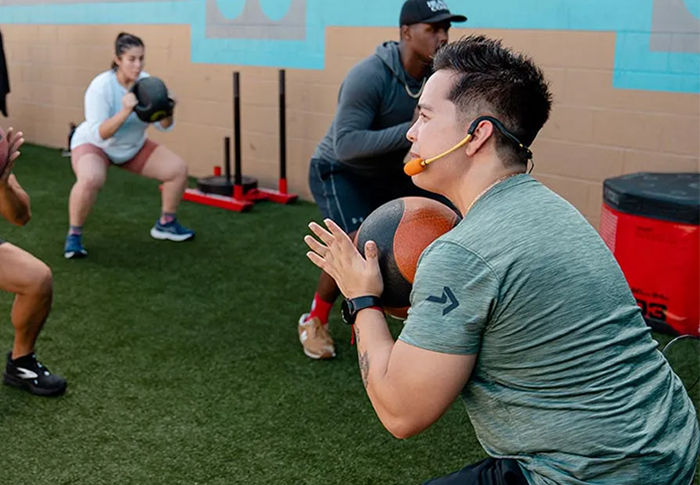
Ask just about anyone how they’re doing and you’re likely to hear the same word repeated over and over: “Busy.” Everyone seems to be short on time, with most people claiming they just don’t have enough of it to do everything they want to do—including exercise. But as Albert Einstein once observed, time is relative. “Time has no independent existence,” he said, “apart from the order of events by which we measure it.” In other words, time is what you make of it—and even the busiest schedules can make room for short bouts of exercise.
I’ve spent much of the last 35-plus years of my career appreciating the impact that short workouts can have and creating workouts that can help clients get extremely fit in a short period of time. I created the following 14-minute metabolic workouts (and wrote the book on which they’re based) as a solution to everyone’s time problem. These workouts make it possible for you to help your clients achieve great results in 14 minutes or less.
If you’re a skeptical person like me, you may think 14-minute workouts sound too good to be true. But if your clients focus and follow the protocols to the letter, they can boost their health and become more fit. Why 14 minutes? Because it’s precise. Your clients will pay attention and focus on the effort because they know they can get in a workout and get back to their busy lives.

Cardio Workouts
Despite the attention the fitness industry gives to skeletal muscles, the heart is where life lives. How well your clients’ cardiorespiratory system works governs, to a large extent, how healthy and fit they are. Research shows that cardiorespiratory fitness is more important than body weight or body mass index in determining overall health and predicting all-cause mortality. In fact, individuals with obesity who have at least a moderate level of cardiorespiratory fitness have about one-half the rate of cardiovascular disease or all-cause mortality than unfit peers with normal weight.
Perhaps the most elegant adaptation the body makes to cardio workouts—especially interval training—is an increase in the size of the heart. The enlargement of the heart’s left ventricle results in a greater stroke volume (the amount of blood the heart pumps with each beat) and cardiac output (the amount of blood the heart pumps each minute). The larger the left ventricle, the more blood it can hold; the more blood it can hold, the more blood (and oxygen) it can pump. Cardiorespiratory fitness is largely dictated by the heart’s ability to pump blood and oxygen.
If you want your clients to maximize their fitness, burn more calories and get the most potent health boost in the least amount of time—like 14 minutes—cardio-interval workouts are the most time-efficient workouts they can do. All the 14-minute workouts featured below are intense, so make sure your clients warm up, starting at a low intensity and progressing to a higher intensity to create a smooth transition from the warm-up to the workout.

VO2max Pyramid
Start with a 5- to 8-minute progressive warm-up, then choose a modality your client can push safely (run, bike, row, sled). During each work rep, coach them to hit 9 RPE (>95% max HR) and return to 1–2 RPE on the 1:30 recoveries, using a timer to keep the exact durations. If heart rate doesn’t drop near baseline or form slips, extend the recovery 30 to 60 seconds and finish with a 3- to 5-minute cool-down.
|
|
Duration (minutes)
|
RPE
|
Intensity
|
|
Rep #1
|
1:00
|
9
|
>95% max HR
|
|
Recovery
|
1:30
|
1–2
|
|
|
Rep #2
|
1:30
|
9
|
>95% max HR
|
|
Recovery
|
1:30
|
1–2
|
|
|
Rep #3
|
3:00
|
9
|
>95% max HR
|
|
Recovery
|
1:30
|
1–2
|
|
|
Rep #4
|
1:30
|
9
|
>95% max HR
|
|
Recovery
|
1:30
|
1–2
|
|
|
Rep #5
|
1:00
|
9
|
>95% max HR
|
|
Total Time
|
14:00
|
|
|
Note: RPE = Rating of perceived exertion on a scale of 0 (easy) to 10 (maximum effort); Max HR = Maximal heart rate
Treadmill Triple-3 Hills: 3 Reps, 3 Minutes, 3% Grade
Use the same workout speed for each rep and the same recovery speed for each recovery interval. For the reps, choose a challenging speed. For the recovery intervals, decrease the speed to a slow jog that enables your client to recover [as measured by rating of perceived exertion (RPE) or heart rate] before the next rep.
|
|
Duration (minutes)
|
Grade
|
RPE
|
Intensity
|
|
Rep #1
|
3:00
|
3%
|
9
|
>90% max HR
|
|
Recovery
|
2:00
|
0%
|
1–2
|
|
|
Rep #2
|
3:00
|
3%
|
9
|
>90% max HR
|
|
Recovery
|
2:00
|
0%
|
1–2
|
|
|
Rep #3
|
3:00
|
3%
|
9
|
>90% max HR
|
|
Total Time
|
13:00
|
|
|
|
Note: RPE = Rating of perceived exertion on a scale of 0 (easy) to 10 (maximum effort); Max HR = Maximal heart rate
Sprint Pyramid
Sprinting increases muscular power by recruiting fast-twitch muscle fibers. It also strengthens the legs, glutes and core. For the recovery intervals, decrease the speed to a slow jog that enables your client to recover [as measured by rating of perceived exertion (RPE) or heart rate] before the next rep.
|
|
Duration (minutes)
|
RPE
|
Intensity
|
|
Rep #1
|
:10
|
9
|
Fast
|
|
Recovery
|
:20
|
1–2
|
|
|
Rep #2
|
:20
|
9
|
Fast
|
|
Recovery
|
:40
|
1–2
|
|
|
Rep #3
|
:30
|
9
|
Fast
|
|
Recovery
|
1:00
|
1–2
|
|
|
Rep #4
|
:40
|
9
|
Fast
|
|
Recovery
|
1:20
|
1–2
|
|
|
Rep #5
|
:50
|
9
|
Fast
|
|
Recovery
|
1:40
|
1–2
|
|
|
Rep #6
|
:40
|
9
|
Fast
|
|
Recovery
|
1:20
|
1–2
|
|
|
Rep #7
|
:30
|
9
|
Fast
|
|
Recovery
|
1:00
|
1–2
|
|
|
Rep #8
|
:20
|
9
|
Fast
|
|
Recovery
|
:40
|
1–2
|
|
|
Rep #9
|
:10
|
9
|
Fast
|
|
Total Time
|
12:10
|
|
|
Note: RPE = Rating of perceived exertion on a scale of 0 (easy) to 10 (maximum effort)
True Tabata
Do this workout on a stationary bike and instruct your client to sprint nearly as fast as possible for each 20-second rep. In Tabata’s original research study, subjects cycled at 170% of maximal oxygen uptake (VO2max), which was determined from VO2max tests in their laboratory, and they did this workout five times per week for six weeks. Your clients should be cautioned against trying this at home.
|
|
Duration (seconds)
|
RPE
|
Intensity
|
|
Rep #1
|
:20
|
10
|
Nearly all-out
|
|
Recovery
|
:10
|
1–2
|
|
|
Rep #2
|
:20
|
10
|
Nearly all-out
|
|
Recovery
|
:10
|
1–2
|
|
|
Rep #3
|
:20
|
10
|
Nearly all-out
|
|
Recovery
|
:10
|
1–2
|
|
|
Rep #4
|
:20
|
10
|
Nearly all-out
|
|
Recovery
|
:10
|
1–2
|
|
|
Rep #5
|
:20
|
10
|
Nearly all-out
|
|
Recovery
|
:10
|
1–2
|
|
|
Rep #6
|
:20
|
10
|
Nearly all-out
|
|
Recovery
|
:10
|
1–2
|
|
|
Rep #7
|
:20
|
10
|
Nearly all-out
|
|
Recovery
|
:10
|
1–2
|
|
|
Rep #8
|
:20
|
10
|
Nearly all-out
|
|
Total Time
|
3:50
|
|
|
Note: RPE = Rating of perceived exertion on a scale of 0 (easy) to 10 (maximum effort)
Adapted from 14-Minute Metabolic Workouts © Jason R. Karp. Used with permission.





 by
by 




